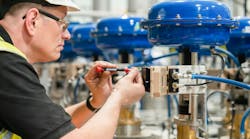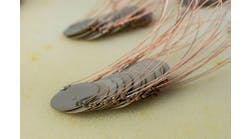One of my primary responsibilities is identifying older equipment that is at risk of failure due to obsolete hardware in the control system and building new controls to replace them. Much of my target equipment started life in the 1980s. It is a tribute to the designers of this equipment that it has survived 40 or more years of daily use and still performs the job it was designed to do.
What is interesting to me is the comparison of what were industry-leading techniques and technology back in 1980 compared to where we are. A recent controls upgrade project provided a reminder of the importance of choosing the right components for pneumatic operations.
Any deep dive into the journey that technology has taken over the past 40 years should start with the statement that, at its base, the principles of operation remain the same.
Pneumatic valves come in three primary types—two-way, three-way and four-way.
Two-way two-position valves can be normally open or normally closed. They are direct acting valves where a single solenoid initiates a shift in the valve to the opposite state, and a spring returns the valve to the normal position after power is removed from the solenoid.
These valves pressure and exhaust one outlet port. The outlet either has pressure or it is blocked, depending on the position of the valve. A good example of use would be a blast of air to blow a product off a conveyor.
Three-way two-position valves can be normally open or normally closed. They are direct acting valves where a single solenoid initiates a shift in the valve to the opposite state, and a spring returns the valve to the normal position after power is removed from the solenoid. These valves pressure and exhaust one outlet port. The outlet either has pressure or it is clear to exhaust, depending on the position of the valve. A good example of use would be an actuator that would energize to extend and de-energize to retract to the original position.
Four-way two-position valves typically have four or five ports and two or three positions. For each position, there are two distinct flow paths for extending and retracting an actuator. In each position, the spool, or valve station, directs flow from the pressure port while the other actuator port exhausts to atmosphere. For a three-position valve, two solenoids are required to shift the spool. In the de-energized state, springs on each end of the valve spool keep the valve in the center position. This is normally all ports blocked and exhaust. To operate an actuator, the desired direction must remain powered on. Removing power returns the valve to the center/blocked position.
These basic principles of pneumatic and hydraulic valves have not changed. Another key principle or rule of thumb is to keep the length of hose from valve to actuator as short as possible. This keeps the action as responsive and quick as possible.
Air is compressible, so the longer the length of hose, the more air must be applied to cause an action at the actuator. For dual port valves, keeping the hoses the same length is also important to keep the extend and retract actions the same.
Flow controls have a considerable impact on the actions of pneumatic devices. When used on an actuator, the flow control limits the release of air on the opposite side of the actuator and is used to control the speed of the action.
Further, end cushions in cylinders create, as the name suggests, a cushion of air right near the end stroke of the actuator. This allows for a speedy main movement, depending on the flow control setting, and then a final deceleration, as it were, of the actuator when it meets up with the cushioned part at the end of stroke. These two functions can be compared to controlling the speed and deceleration of a variable-frequency drive to control the motion of a motor-driven device.
None of the preceding details changed much over the years. Individual manufacturers continue to tweak an already good and long-standing product to further improve the function. For example, the inner chambers and paths in both valves and actuators are worked on to improve the flow of air to optimize performance.
One manufacture I work with has come up with a new valve body that uses the same physical size but a significantly improved volume of airflow. This increases speed of shifting and, by association, greater speed of the actuator.
For a designer, understanding how pneumatic devices behave is a very important part of coming up with a good controls package. For example, due to the use of flow controls and end cushions, some movements that are physically longer would benefit from sensors to indicate the position of the actuator.
We cannot rely on time because that can vary, depending on the settings for flow or end cushion. In critical movements where paths might cross with other actuators, assuming that an actuator is out of the way, based on time, will likely result in a collision.
The biggest development in pneumatic control likely came out of the understanding that the distance from a valve to an actuator is critical. In larger machines or process applications, the distance from the control cabinet to the field device might be quite long. The solution to that was to mount the manifold or a smaller version of it on the machine, close to the devices.
Traditionally, machine wiring would carry the signals to that machine-mounted manifold. This added some latency to the actions due to the inherent lag associated with sending signals over long distances, but it took care of keeping the actuator connections as close to the valve manifold as possible.
Thankfully, the fieldbus entered the picture. A fieldbus does just that, moves the originator of the signals from the main control panel to the field-mounted device using communications.
Communications, even in the earlier days of this technology, was much faster than the physical wires strung on the machine. Instead of a multiconductor cable strung along the frame of the machine, the communications cable consisted of a few conductors, as few as two or five plus a shield, in its own protected jacket.
The first versions of this technology involved mounting field, or remote, I/O stations at strategic locations on the machine or process and then controlling the pneumatic devices from that close proximity. Power plus communications cables were the only wires needed to get from the main cabinet to the remote station.
The real innovation came from these original concepts. Pneumatic vendors thought to combine the remote I/O with the manifold directly, in one bundle that could be mounted right there on the side of the machine.
Contained in the manifold block is a communications module talking in whatever version of fieldbus the designer chooses to use. The control of the manifold is direct terminations that happen from the communications module to the backplane of the manifold—neat, clean and protected.
We now have the ultimate version of this concept. If you have pneumatic devices, you likely also have inputs and outputs in the immediate vicinity. Instead of mounting a separate remote I/O station, why not have modules that connect directly to the valve manifold and use that same backplane connection to talk to the embedded communication module?
The number of additional I/O modules is only restricted by the fieldbus protocol and the capabilities of the communications module.
The use of fieldbus technology is changing the way we design and build machines and processes. It drastically cuts down on wiring and puts specialty function modules on a machine where they once were restricted to the main processor rack in a control cabinet.
Where we once had to put such equipment in a protective enclosure on a machine, many of the fieldbus on-machine devices can live right there in the harsh environment, again reducing design and build costs. Since these devices are usually field-configurable, the ability to add or subtract manifold stations and input/output stations at a time after design makes them all the more attractive.
Adapting to change can be hard. As humans, we seem bound to resist such changes, and that can hold us back at times. Challenges can exist, for example, when upgrading a system that didn’t have a proper safety circuit in it. By adding that safety circuit and the necessary means to cut off power to field devices, we created an issue where a dust control valve that needed to stay open for cleaning was closing when we hit the e-stop.
Using technology and knowledge, we were able to change the control at the device to use a double-ended valve that would stay in the last position if we pressed an e-stop to drop power. Using the new technology in our upgrade saved the day for us because we already had additional control points in the manifold and simply changed out the valve.





